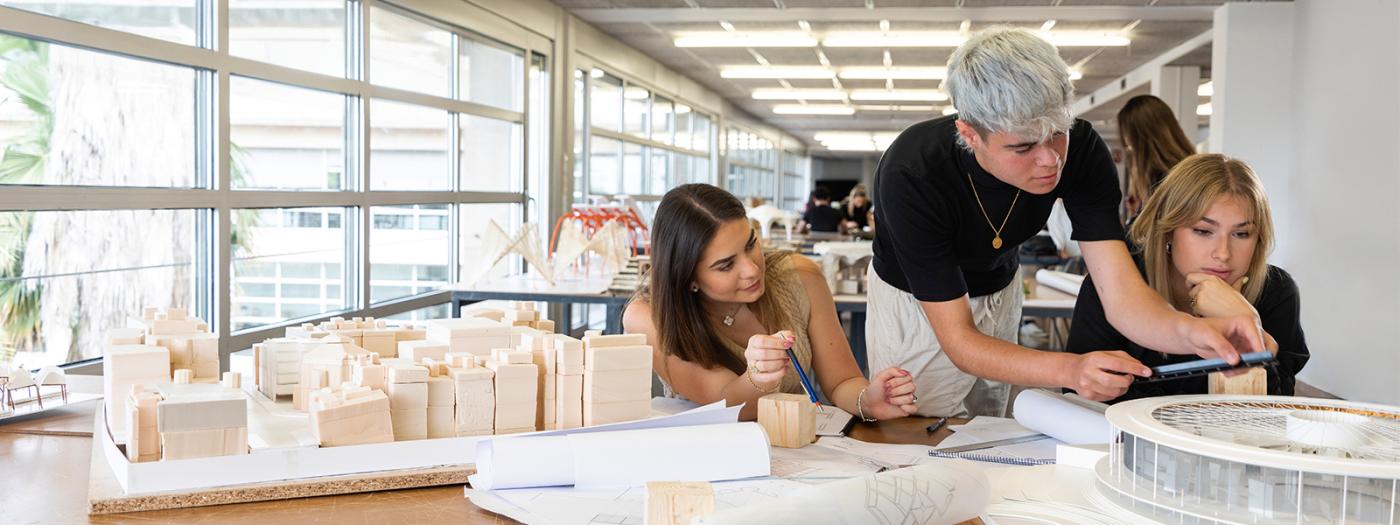Titular Professors
It is required that the student has drawing skills to express his/her ideas and to explain them graphically.
Learning Outcomes of this subject are:
Generals
RA.05 Ability to understand the relationships between people and buildings and between buildings and their surroundings, as well as the need to relate buildings and spaces located between them according to human needs and scale.
Specifics
RA1 Analyze the architectural design project in relation to its geographical, historical, social context, recognizing the value of the qualities of the place
RA2 Develop the architectural design at a technical, constructive, structural, climatic level...
RA3 Represent the architectural design project following the established graphic criteria and publicly present the synthesis of the design.
First, the course tries to equip students with the skills that they will need to represent any idea or proposal: drawing in plans and perspective, and modelling.
On the other hand, the students must familiarize themselves with, and understand the elements that architecture uses, namely elements as structures, stairs, walls, doors, windows, roofs etc. and learn that construction is the science that shows how to relate materials through techniques to build a project.
As the course advances in the process of designing, they will start to understand that architecture is a formal invention based on the knowledge of the original conditions that are transformed and of the techniques that make it possible to be constructed.
The course also tries to explain that architecture is plural and must deal with cultural backgrounds. For this purpose, the student will have to analyze different architectures.
Since it is a practical subject, based on the student work within a design studio environment, the course consists of a series of exercises that lead them to get the capacities objective of the subject:
-First observation and drawing: deducting proportions from a photographic view from an outstanding building exterior or interior. Objects and spaces representation.
-Exercises of transformation of architectural elements.
-Analysis and drawing of the disposition of a building and the elements of its construction.
-Exercises of transformation of the analyzed building, in which the site conditions are given as a starting point, so that students are committed to respecting, facing real problems in parallel to form or other aesthetic considerations.
Public revisions of the work, as well as explanations, lectures and visits allow the student to find references to deep on any particular design project solution.
The subject is a design studio in which students work and revise their proposals in the classroom: it is mainly practical.
It has a learning by doing methodology, applied in the analysis as well as in the design exercises. Therefore, Personal implication is the main key to learn.
Students gather in groups of a maximum of twenty people, each of them conducted by a teacher. Given an exercise, a debate is conducted about similar situations and questions arise about that help to identify the purpose to achieve and guide the work. Once the student has started to work, the teacher debates the proposal, recommends, and backs the student in his/her development of the project.
The first exercises are concrete and very limited, focused on the architectural elements within the design project. Afterwards there will be an exercise of analysis of modern architecture examples, and finally a small transformation of them. By the end of the course, the students will have faced a great variety of aspects that the project addresses.
On the days indicated as submission, the exercise must be uploaded to the eStudy before deadline and in PDF format.
Attendance to classes is mandatory, missing more than the 20% of them, even if justified, leads to a not presented grade.
Dedication
Subject dedication 5 ECTS * 25 hours/credit = 125 hours
Semestral dedication 14 weeks (12 classes + 2 evaluation)
Weekly dedication 9 hours/week
Total dedication:
-Lectures 4 hours
-Workshop 46 hours
-Homework 62,5 hours
-Juries 4,5 hours
-Aula BCN 8 hours
For the evaluation of the student work, the teachers will consider the ability or the student to respond to the given problem to solve it, the reflection on the data, the ability to conduct the work and the ability to develop it. Personal implication and design presentation is taken into account.
The student skills and knowledge are evaluated through the following work and submissions:
-Highly significant evaluation activities:
*Projects
*Presentations
*Jury
-Moderately significant evaluation activities:
*Home and schoolwork as well as individual and team work
*Team analysis of buildings
*Continuous assessment
*Corrections
The teachers will consider the ability or the student to respond to the given problem to solve it, the reflection on the data, the ability to organize, conduct, develop the work and represent it. Assistance to classes is fundamental to follow the course.
Criteria for the evaluation of the observation and representation exercises:
OBSERVATION&ANALYSIS (20%): comprehension
DEFINITION (40%): proportions/relationships among parts, details, materialization/construction
PRESENTATION (30%): clarity of the drawing, composition
IMPLICATION (10%): explanation, attendance
Criteria for the evaluation of the analysis exercises:
INITIAL ANALYSIS (20%): graphic historical documentation, site plan
THOROUGH ANALYSIS (40%): concept and evolution, program display, structure/materialization/construction
REPRESENTATION (30%): graphic representation, models
IMPLICATION (10%): explanation, participation, attendance
Criteria for the evaluation of the design proposal exercises:
ANALYSIS AND APPROACH (20%): environment, objectives, and approach
PROJECT DEVELOPMENT (40%): concept evolution, program adaptation, materialization/structure/construction
PRESENTATION (30%): graphic presentation, models
IMPLICATION (10%): explanation, participation, attendance
Blake, P. `Maestros de la Arquitectura Moderna´
Gídeon, S. `Espacio, Tiempo, Arquitectura´
Gombrich, E. `Historia del Arte´
Zevi,B. `Saber ver la arquitectura´
Siza, A. `Conversaciones con Valdemar´
Summerson,J. `El lenguaje clásico de la arquitectura´
Koolhaas,R. `Elements of Architecture´
Alexander,C. ` Pattern Language´
